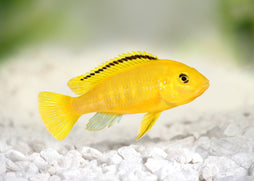Description
Nanochromis transvestitus is a rare and visually unique dwarf cichlid species endemic to the lower Congo River in Central Africa. This riverine species is best known for its dramatic sexual dimorphism—females are more vibrantly coloured than males, an unusual trait among cichlids. N. transvestitus thrives in soft, acidic water with dense cover and a natural aquascape. Its compact size and fascinating behaviour make it ideal for intermediate hobbyists maintaining a carefully managed West African biotope.
Features of Nanochromis transvestitus
• Reaches a maximum size of 5–6 cm
• Females display deep red to magenta abdomens with striking black and white vertical barring
• Males are more slender, with a more muted colour palette and less contrast
• Exhibits biparental cave spawning behaviour
• Territorial but generally peaceful with compatible species
• Lifespan averages 5–7 years with proper care
The best aquarium size for Nanochromis transvestitus
A minimum tank size of 60 litres is suitable for a bonded pair. For multiple pairs or a small community, a 90-litre tank or larger is preferred. Horizontal space and dense cover are more important than height, as this species occupies the lower and middle levels of the tank.
Tank Mate Compatibility for Nanochromis transvestitus
• Ember Tetra
• Congo Tetra (dwarf strains or juveniles only)
• African Red-Eyed Tetra (Arnoldichthys spilopterus)
• Upside-Down Catfish (Synodontis nigriventris)
• African Butterfly Fish (Pantodon buchholzi)
Diet for Nanochromis transvestitus
This species is omnivorous with a strong preference for small invertebrates. Offer high-quality micro pellets and supplement with live or frozen foods such as daphnia, cyclops, brine shrimp, and bloodworms. Avoid large or hard foods that may damage their small mouths. Feed sparingly and maintain pristine water quality.
Aquarium Setup Nanochromis transvestitus
Aquarium Filtration
Use a gentle, high-efficiency sponge or internal filter to maintain stable water without strong current. Soft, acidic water (pH 5.5–6.5) with low to moderate hardness (2–6 dGH) is essential for long-term health and breeding success.
Aquarium Plants
Dense planting with species like Cryptocoryne, Anubias, and Java moss is recommended. Floating plants such as Amazon frogbit help diffuse lighting and reduce stress. Plants should be arranged to create shaded territories.
Aquarium Lighting
Low to moderate lighting is best. Avoid intense or direct light, which may stress the fish and suppress natural behaviours. Use soft-spectrum LED lighting to simulate a shaded, tannin-stained river environment.
Aquarium Heating
Maintain temperatures between 24–27 °C using a reliable heater. Temperature stability is critical, especially in smaller systems and during breeding.
Aquarium Substrate
A soft, dark sand substrate replicates the natural riverbed and supports natural digging and foraging behaviours. Avoid coarse gravel or sharp-edged substrate.
Aquarium Decorations
Use driftwood, leaf litter, and coconut shells to create hiding spots and encourage natural breeding behaviour. Rockwork may be added but should not dominate the aquascape. Include shaded areas and visual barriers to reduce aggression and promote territory formation.











